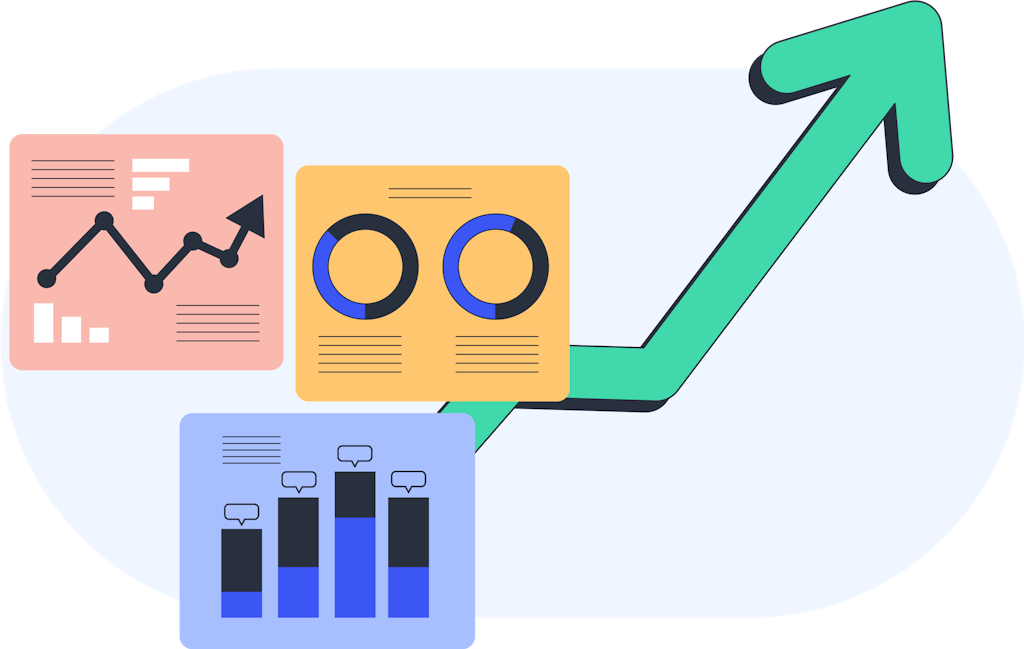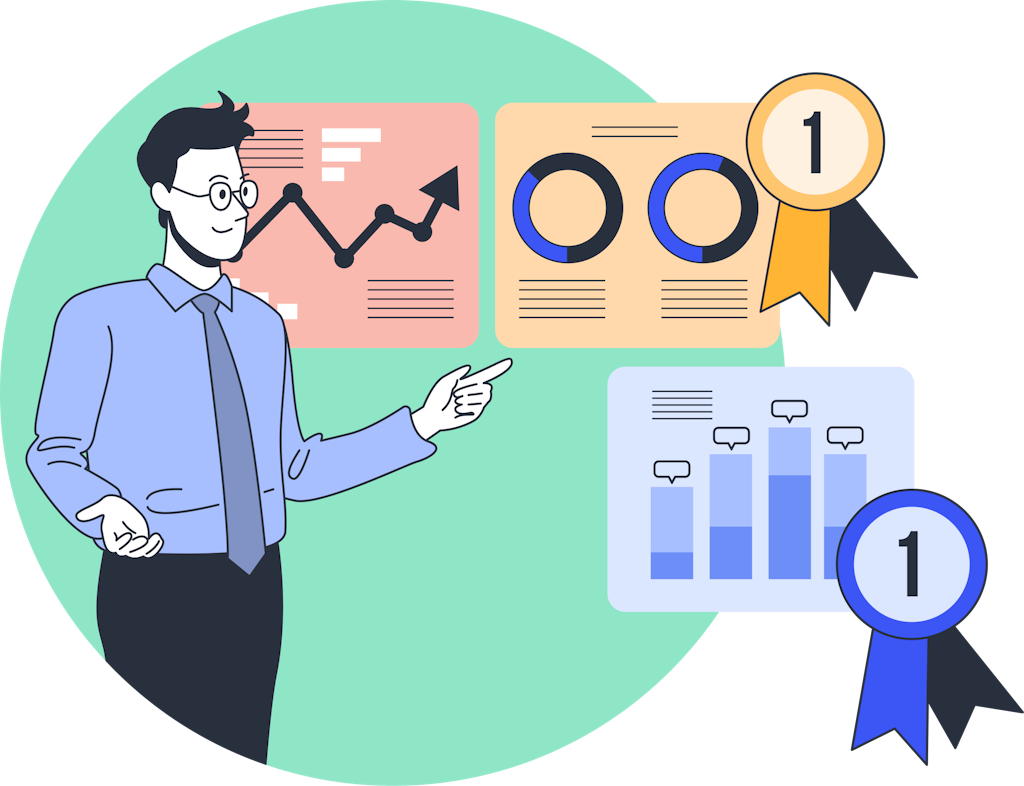A Complete Guide on Marketing Data
A Complete Guide on Marketing Data

The Importance of Data in Marketing
The Importance of Data in Marketing
Data forms the foundation for successful marketing efforts, offering valuable insights that drive decision-making and shape strategy development. Here are other reasons why data is significant in marketing and how data-driven insights empower businesses to achieve their marketing goals effectively.

1. Informed decision-making
Marketing data offers a comprehensive view of various key performance indicators (KPIs), such as customer acquisition costs, conversion rates, customer lifetime value, and more.
2. Understanding customer behavior
Assessing data from various sources, including website interactions, social media engagement, email open rates, and purchase history, helps marketers create detailed customer profiles.
3. Personalization
Marketing data allows businesses to segment their audience based on various attributes, such as demographics, behavior, interests, and past interactions.
4. Targeted marketing campaigns
Understanding customer preferences and behavior allow marketers to identify the most promising customer section and direct their marketing efforts toward them.
5. Measuring marketing effectiveness
Key performance indicators (KPIs), such as click-through rates, conversion rates, and customer acquisition costs, can be tracked and analyzed to assess the success of specific marketing initiatives.
6. Customer journey optimization
Examining data at each stage of the customer journey help businesses to spot opportunities for refinement and create a seamless, cohesive experience for their customers
7. Identifying market trends
Analyzing data from various sources and monitoring industry trends allow businesses to recognize emerging opportunities and adapt their marketing strategies to stay ahead of the competition.
8. Enhancing customer experience
By leveraging data, businesses can offer personalized interactions, timely support, and relevant content, improving customer satisfaction.
9. ROI optimization
Measuring the performance of various marketing initiatives enables businesses to allocate their resources more effectively, investing in strategies yielding the highest ROI.

10. Continuous improvement:
Through data analysis and performance tracking, businesses can understand areas for improvement in their marketing strategies.
Data is the backbone of modern marketing, empowering businesses to make informed decisions, understand their customers, and create personalized experiences.
See the magic for yourself
Why waste time on propsects that don't convert?
Book a free trial and get 50 free leads.
Types of Marketing Data
Types of Marketing Data
Businesses can access various data sources providing valuable insights into consumer behavior, preferences, and market trends. Let's explore the different types of marketing data available to businesses.

1. First-party data
First-party data is the information businesses collect directly from their audience or customers. Businesses obtain this data through touchpoints such as website interactions, mobile apps, customer feedback forms, purchase history, and loyalty programs.
First-party data is highly reliable and accurate since it comes directly from the source. It allows businesses to build personalized customer profiles, understand customer preferences, and improve customer experience.
The scope of first-party data is limited to existing customers or website visitors, which may not provide a comprehensive view of the target audience.
2. Second-party data
Second-party data is another company's first-party data, shared or exchanged between businesses through partnerships or agreements. This type of data sharing allows businesses to access additional data sources they might not have collected directly.
Second-party data can access a broader audience segment or new data points complementing a business's existing first-party data. It allows for increased reach and better targeting capabilities.
The reliability and accuracy of second-party data depends on the data source, and businesses need to ensure that the data is trustworthy and relevant to their marketing objectives.
3. Third-party data
Third-party data is data businesses acquire from external sources, such as data aggregators, brokers, or other third-party vendors. Businesses collect this data from various online and offline sources, including public records, social media, and online behavior.
Third-party data can enrich a business's understanding of its target audience and provide insights into new customer segments. It helps businesses reach a wider audience and expand their marketing efforts.
However, the quality and accuracy of third-party data can vary widely, and businesses should vet data providers to ensure data reliability carefully.
4. Structured Vs. Unstructured Data
Structured data is well-organized and formatted data that fits neatly into predefined fields and rows within a database. Examples include customer names, addresses, purchase amounts, and dates. Structured data is easy to analyze, query, and process, making it ideal for generating reports and running data analytics.
Unstructured data does not conform to a specific format and lacks a predefined structure. Businesses can collect this data from social media posts, customer reviews, images, and video content.
Unfortunately, unstructured data is more challenging to analyze using traditional methods, but it holds valuable insights that can provide a deeper understanding of customer sentiment and behavior.
Collecting Marketing Data
Collecting Marketing Data
Businesses can access many methods and sources to collect valuable marketing data, from website analytics to customer surveys. Each technique is crucial in understanding customer behavior, preferences, and market trends. Here are some key methods and sources businesses utilize to collect data.

1. Website Analytics
Website analytics allows businesses to understand user behavior and engagement on a website. It involves tracking and analyzing user interactions to gain insights into website performance and audience preferences.
Just like Google Analytics, analytics tracks and analyzes user interactions, such as page views, bounce, and click-through rates.
Metrics such as bounce rate, conversion rate, and traffic sources are essential for monitoring website performance. Conversion tracking allows businesses to measure specific user actions, such as completing a purchase or signing up for a newsletter.
2. Customer Relationship Management (CRM) Systems
CRM systems help centralize customer information and interactions. These systems store and manage contact information, purchase history, and customer preferences, providing businesses with a comprehensive view of their customers.
Businesses can use CRM data to segment their customer base for personalized marketing efforts. CRM facilitates lead nurturing and customer retention by tracking customer interactions and ensuring timely follow-ups
3. Surveys and Feedback
Direct customer feedback is a valuable data source that offers businesses insights into customer preferences, satisfaction levels, and pain points.
Effective survey methods like online forms and email surveys allow businesses to collect relevant and actionable data. Also, actively using customer feedback can lead to product/service improvements, increased customer loyalty, and positive brand sentiment.
4. Data Aggregation and Integration:
Data aggregation involves collecting and consolidating data from various marketing channels and touchpoints to gain a holistic view of customer behavior and preferences.
Aggregating data from different marketing channels, such as social media, email campaigns, and website interactions, allows businesses to identify cross-channel trends and customer touchpoints.
Cleaning and Analyzing Marketing Data
Cleaning and Analyzing Marketing Data
Accurate and reliable marketing data is the foundation of successful data-driven marketing strategies. Effective data analysis relies upon data cleanliness and accuracy, which can be achieved through various techniques.

1. Data Cleaning Techniques
Data cleaning ensures the accuracy and reliability of marketing data. It involves identifying and rectifying inconsistencies, errors, and missing values in the dataset.
Data cleaning removes duplicates, ensuring each record is unique and representative of a single data point. Standardizing data formats ensures uniformity and consistency across the dataset.
Techniques for handling missing values involve filling in gaps with appropriate data, such as using averages or statistical imputation methods.
2. Data Enrichment
Data enrichment is enhancing existing datasets with additional information from external sources. By enriching data, businesses can gain deeper customer insights and better understand their target audience. Examples of data enrichment techniques include adding demographic, firmographic, or behavioral data to customer records.
3. Data Segmentation
Data segmentation involves dividing data into groups based on specific criteria such as demographics, behavior, or preferences. This approach enables businesses to tailor marketing messages and offers to different customer segments.
Targeted marketing increases the relevance and engagement of marketing campaigns, leading to higher conversion rates.
4. Data Visualization Tools and Techniques
Data visualization enables businesses to visually identify patterns, trends, and outliers, facilitating data-driven marketing decision-making. Data visualization uses graphical representations such as charts, graphs, and dashboards to display insights, making complex data more understandable and actionable.
By presenting data visually appealingly, data visualization tools promote better communication of marketing insights and facilitate data-driven decision-making.
The Role of AI in Marketing Data
The Role of AI in Marketing Data
The transformative impact of artificial intelligence lies in its ability to handle vast amounts of data, extract valuable insights, and enable data-driven decision-making. Ways how businesses harness AI in marketing data includes the following list.

1. AI and Predictive Analytics
Predictive analytics powered by AI allows businesses to forecast future trends and customer behavior based on historical data. It also enables marketers to make proactive decisions, optimize marketing campaigns, and allocate resources effectively.
AI algorithms analyze historical data to identify patterns and trends that are not apparent through traditional analysis. Predictive analytics enhances lead scoring, helping businesses focus on high-potential leads and improve conversion rates.
2. Personalization through AI
AI-driven personalization revolutionizes customer experiences by tailoring marketing content and recommendations to individual customers, fostering stronger customer engagement and brand loyalty.
AI leverages customer data to create personalized experiences from websites and email campaigns. In addition, product recommendations based on customer preferences increase cross-selling and upselling opportunities.
3. Sentiment Analysis and Natural Language Processing (NLP)
Sentiment analysis and NLP empower businesses to gauge customer emotions and opinions by analyzing unstructured data sources like customer reviews and social media posts. It provides valuable insights into brand reputation and customer satisfaction.
NLP techniques allow AI systems to understand and interpret human language, making sentiment analysis feasible. Sentiment analysis analyzes customer feedback, reviews, and social media posts to determine whether sentiment toward products or brands is positive, negative, or neutral.
It allows businesses to assess brand perception, identify potential issues, and make data-driven decisions to address concerns.
See the magic for yourself
Why waste time on propsects that don't convert?
Book a free trial and get 50 free leads.
Leveraging Marketing Data for Better Campaigns
Leveraging Marketing Data for Better Campaigns
Marketing data significantly enhance the outcomes of marketing campaigns. Here is how businesses can utilize marketing data to identify target audiences, optimize content and messaging, improve customer experiences, and measure marketing effectiveness.

Target Audience Identification
Marketing data helps identify the right target audience for a campaign. Businesses can segment their customers and prospects by analyzing demographic and behavioral data, allowing them to create personalized and relevant marketing messages.
Segmentation based on demographics, behavior, interests, and preferences enables businesses to create tailored campaigns for specific customer segments, increasing customer engagement and conversion rates.
Content and Messaging Optimization
Data-driven content optimization ensures businesses create relevant and engaging content for different customer segments.
A/B testing and data-driven experimentation refine marketing messages, leading to higher conversion rates and engagement.
A/B testing different variations of marketing messages helps determine the most effective ones for different segments. Personalized content based on individual customer characteristics and interactions enhances the relevance and impact of marketing content.
Improving Customer Experience
Data analysis enables businesses to understand customer pain points and preferences to improve customer experiences. Personalization strategies deliver tailored experiences at various levels, boosting customer satisfaction and loyalty.
Businesses gain insights into customer pain points and preferences by gathering and analyzing customer data.
Measuring Marketing Effectiveness:
Marketing data provides valuable insights into the success of marketing campaigns. By tracking and analyzing key performance indicators (KPIs), businesses can assess the effectiveness of their marketing efforts, refine strategies, and better allocate resources.
By measuring the success of marketing campaigns and assessing return on investment (ROI), businesses can make data-driven decisions for improvement and optimization.
Lookalike Leads and B2B Lead Generation with Ocean
Lookalike Leads and B2B Lead Generation with Ocean
Lookalike leads are a powerful tool for businesses seeking to expand their customer base and drive higher conversion rates. Let's explore the concept of lookalike leads, the role of AI in identifying them, the benefits of lookalike lead generation, and successful B2B lead generation stories.

Understanding Lookalike Leads
Lookalike leads are prospects who share similarities with a company's existing high-quality leads. These potential customers possess similar characteristics, interests, and behaviors, making them ideal targets for businesses looking to grow their customer base.
Lookalike modeling, powered by data analysis, identifies patterns and common traits among existing high-quality leads. It allows businesses to target similar prospects and increase the likelihood of lead conversion due to shared characteristics with their existing customers.
The Role of AI in Identifying Lookalike Leads:
Using advanced algorithms and machine learning, AI analyzes vast datasets to identify patterns and correlations, predicting potential leads with high conversion probability.
In addition, AI-driven tools and platforms leverage machine learning models to predict potential leads with characteristics similar to existing high-quality customers.
By automating the lead generation process, AI saves time and resources, improving the efficiency of B2B lead generation.
Benefits of Lookalike Lead Generation
Personalized marketing to specific segments based on lookalike traits ensures relevance and effectiveness in marketing campaigns.
By targeting high-quality prospects with similar characteristics to existing customers, businesses can maximize their marketing ROI and achieve better sales outcomes.
Success Stories of B2B Lead Generation Companies Using AI
Salesforce, a leading cloud-based CRM platform, has embraced AI in its B2B lead generation efforts. They introduced Einstein, an AI-powered platform that analyzes vast amounts of data from multiple sources, including customer interactions, website behavior, and social media, to identify patterns and predict lead conversion probabilities.
Another example is Ocean.io, an innovative B2B lead generation company that has also significantly impacted the industry by harnessing the power of AI to revolutionize how businesses identify and target potential customers. Through its AI-driven solutions, Ocean.io has helped numerous B2B companies enhance their lead generation efforts and achieve remarkable success.
Ensuring Data Privacy and Security
Ensuring Data Privacy and Security
As businesses collect and utilize vast amounts of customer data, it's crucial to adhere to data protection regulations, implement best practices for data security, and uphold ethical considerations in data usage to build and maintain customer trust.

Compliance with Data Protection Regulations
Major data protection regulations like the General Data Protection Regulation (GDPR) and the California Consumer Privacy Act (CCPA) aim to safeguard individuals' data.
Businesses must obtain explicit consent from individuals for data usage, implement measures to handle data access and deletion requests and conduct regular audits to ensure ongoing compliance to comply with regulations.
Failure to comply with data protection regulations can lead to severe consequences, including hefty fines and damage to a company's reputation.
Best Practices for Data Security
Implementing robust data security measures is essential to protect sensitive customer information from unauthorized access and data breaches. Data encryption and access controls can safeguard sensitive data.
Regular data security audits and vulnerability assessments help identify and address potential weaknesses. Also, real-time monitoring and detection of potential data breaches enable businesses to respond promptly and mitigate the impact.
Training employees on data security protocols and best practices ensures an organization's security culture.
Ethical Use of Marketing Data
Ethical data usage means refraining from discriminatory or invasive data practices that could compromise customer privacy and trust. Businesses must avoid data misuse, ensuring customer information is used only for the intended and consented purposes.
Transparency in data usage is crucial. For example, providing customers with clear opt-out options demonstrates ethical data practices. By safeguarding customer data and using it responsibly, businesses can enhance their reputation, foster stronger customer relationships, and drive long-term success in the competitive landscape.
Future Trends in Marketing Data
Future Trends in Marketing Data
Marketing data has unending advancements driven by artificial intelligence (AI), data-driven decision-making, and a strong emphasis on personalization and hyper-targeting. These trends can revolutionize marketing strategies and redefine how businesses interact with customers.

1. AI Advancements in Marketing
AI-driven marketing data analysis can reform customer insights, personalization, and targeting. AI optimizes ad targeting, personalization, and customer journey mapping, enhancing marketing efficiency and effectiveness.
In addition, improvements in AI-powered predictive analytics improve customer insights, enabling businesses to better understand customer behavior and preferences. AI-powered chatbots and virtual assistants enhance customer interactions, delivering seamless and personalized experiences.
2. Data-Driven Decision Making
Data analysis optimizes campaign performance and resource allocation, ensuring marketing efforts are focused on the most promising opportunities. Data-driven insights can lead to more accurate and effective marketing strategies, as decisions are based on factual data rather than assumptions.
Real-time data analytics provides timely insights, enabling agile strategies and responsive marketing approaches. Predictive modeling informs proactive marketing campaign planning, enabling businesses to stay ahead of customer needs and preferences.
A/B testing and data experiments refine marketing approaches, leading to continuous improvement in marketing strategies.
3. Personalization and Hyper-targeting:
Marketing data delivers targeted content and offers to specific customer segments, enhancing relevance and engagement.
Personalization reaches new heights with AI-driven customer profiling, allowing businesses to understand customers more deeply.
Hyper-targeted marketing delivers tailored messages to specific segments, ensuring marketing efforts resonate with the intended audience. Behavioral data analysis enhances personalized customer experiences, enabling businesses to anticipate customer needs and preferences.
Dynamic content adapts to individual preferences in real-time, delivering personalized messages across various touchpoints.
Remove the Guesswork From
Business Growth
Remove the Guesswork From Business Growth
With our AI-driven solutions, Ocean.io empowers B2B companies to enhance their lead generation efforts, achieve remarkable success, and stay ahead in the competitive landscape. By leveraging data-driven insights and personalized targeting, you can unlock the potential of your B2B marketing campaigns. Contact us today to unlock your B2B lead generation potential with our AI-powered solutions.
Contact us With our AI-driven solutions, Ocean.io empowers B2B companies to enhance their lead generation efforts, achieve remarkable success, and stay ahead in the competitive landscape. By leveraging data-driven insights and personalized targeting, you can unlock the potential of your B2B marketing campaigns. Contact us today to unlock your B2B lead generation potential with our AI-powered solutions.